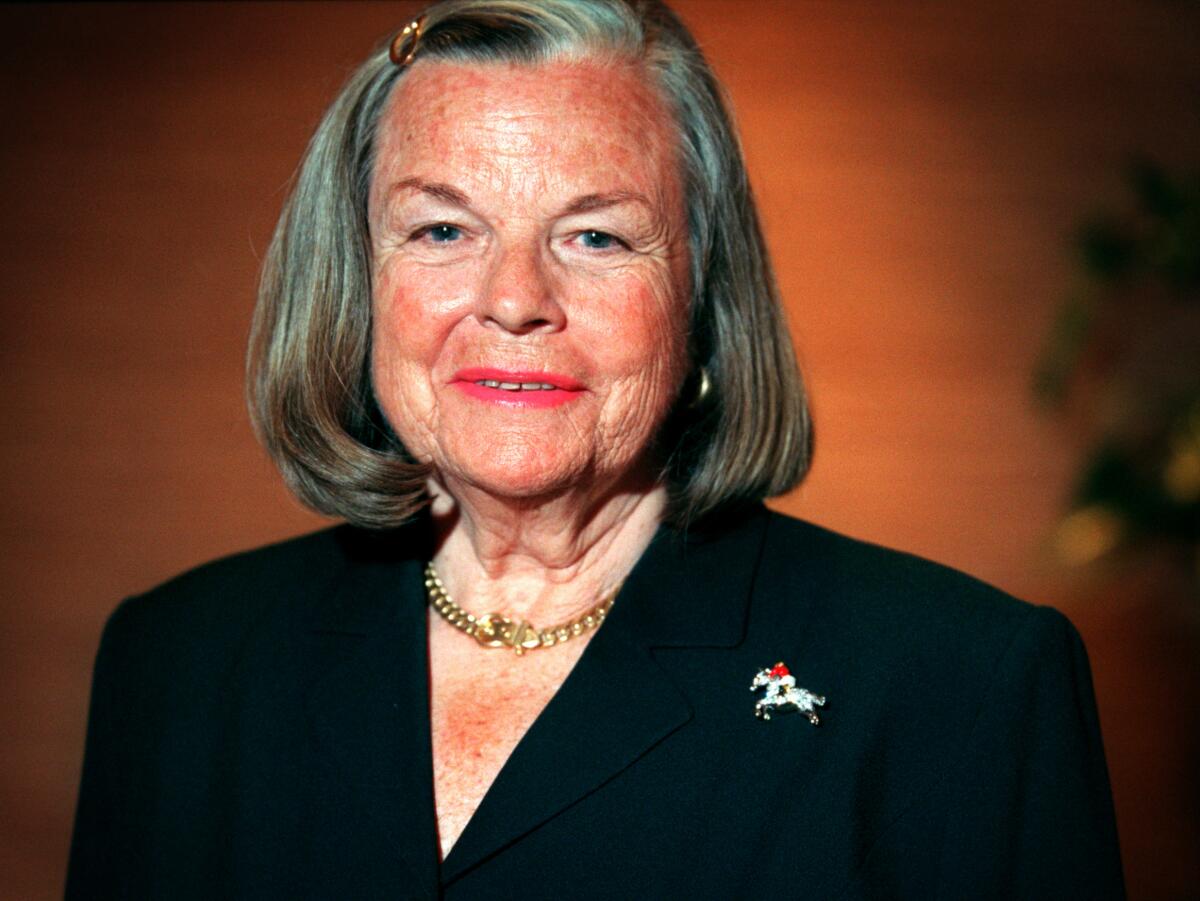Joan Irvine Smith, daughter of O.C. land baron family who helped establish UC Irvine, dies at 86

- Share via
Joan Irvine Smith, a philanthropist, arts patron and heiress to one of Orange County’s founding fortunes who was instrumental in establishing UC Irvine, died Thursday, her family said. She was 86.
She was born in 1933 as Athalie Anita Irvine and raised in Beverly Hills, Pasadena and what was then rural Orange County. Her father died of tuberculosis when she was 2, and by age 4 she was calling herself Joan, inspired by the character of “Little Jumping Joan” in a Mother Goose nursery rhyme.
The family business, the Irvine Co., was founded by her grandfather, James Irvine II, and the family ranch originally covered more than 110,000 acres, or nearly one-third of Orange County.
On his death in 1947, she inherited a minority share of the company, which he had left in the control of a nonprofit philanthropic foundation, the James Irvine Foundation, whose board she would battle for years.
She was 24 years old in 1957 when she joined the Irvine Co.’s board of directors, replacing her mother as its only female member. “It was then that I began my very liberal education in the machinations of corporate intrigue,” she said years later.
She quickly established herself as an independent-minded board member and, to other members, a frequently vexing dissenting voice. Its then-chairman called her “spoiled” and “guided by self-interest.”
Smith fought the board to prevent what she called the “rapid and disorderly development of the ranch lands,” and was said to carry a hidden tape recorder to board meetings, so deeply she distrusted other members.
After years of lobbying, she and her lawyers persuaded Congress to change the tax code to curb tax-exempt foundations from running private firms, which helped her to finally dislodge the foundation from dominance over the company.
She waged a campaign — which she described as “a frequently bitter two-year battle” — to force the Irvine Co. board to donate 1,000 acres of land in 1960 for the campus of UC Irvine. She touted it as a good business decision, pointing to the economic effect UCLA had had in Los Angeles.
She also helped to persuade the board — after what she described as another bitter fight — to adopt the plan of architect William Pereira that established the UC campus as the focus of an elaborately master-planned “city of intellect.”
Sometimes described as regal, eccentric and irascible, she portrayed herself as a guardian of the Irvine Co., founded by her grandfather.
In her backyard swimming pool in San Marino, she once nursed a sick seal and then used a lasso to catch it when it was well enough to flee.
Fearful of being kidnapped, she traveled with bodyguards, shuttled between homes in Laguna Beach and Newport Beach, and was known to keep a loaded 12-gauge shotgun close by.
In the early 1980s she feuded publicly with Donald Bren, who had become the Irvine Co.’s majority shareholder, and fought unsuccessfully in court to block his proposal to merge the firm with his holding company. She said the merger was unfair to minority shareholders like herself and would saddle the company with heavy debt.
“If I had more faith in Bren, it would be a different matter,” she said at the time. She accused Bren of understating the company’s value and her stock. She finally severed ties with the company in 1990, when she and her mother took a $256-million buyout.
In a statement after her death, Bren described her as “a longtime friend.”
“She was a very important participant in the history of the all-new city of Irvine and Orange County,” Bren said. “She will be missed.”
She made the Forbes list of richest Americans in the early 1990s, with an estimated $350-million fortune, but did not seem to lament her later exclusion from the list.
Smith went to high school at Westridge, a private girls’ school in Pasadena, and briefly attended Marymount College and UC Berkeley before dropping out.
She was married and divorced four times.
She married a lifeguard, a Navy flyer, a contractor and a horse breeder 19 years her senior named Morton “Cappy” Smith, with whom she lived on a Middleburg, Va., farm. They divorced in 1979 after 16 years of marriage. She is survived by her three sons, James Irvine Swinden, Russel S. Penniman IV, and Morton Irvine Smith, and six grandchildren.
She championed Crystal Cove State Park on part of what had been her family ranch and founded the Irvine Museum, which she filled with her art collection, notably in the genre of California impressionism.
Observers sometimes speculated that she was trying to atone for her family’s role in paving over a good portion of the county. In 2001, when she stood up to oppose a developer’s plan to put new cottages at Crystal Cove State Park, the crowd chanted her name. The plan was defeated.
Smith also played a role in establishing the Laguna Coast Wilderness Park, the Irvine Park and the Irvine Bowl.
“She wanted to carry the mantle of the family and felt strongly about preserving her grandfather’s legacy,” said Ellen Bell, a board member of the Orange County Historical Society and a historian of the area. “She was part of the movement that made the city of Irvine of today possible.”
More to Read
Start your day right
Sign up for Essential California for the L.A. Times biggest news, features and recommendations in your inbox six days a week.
You may occasionally receive promotional content from the Los Angeles Times.







